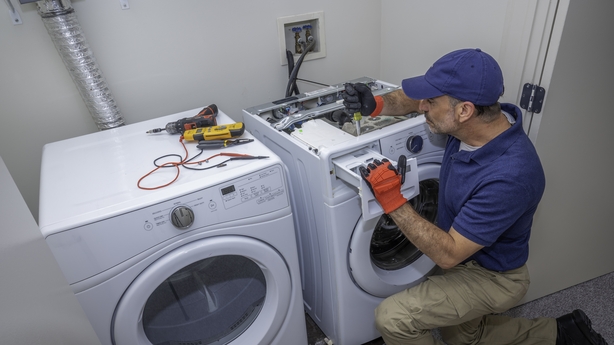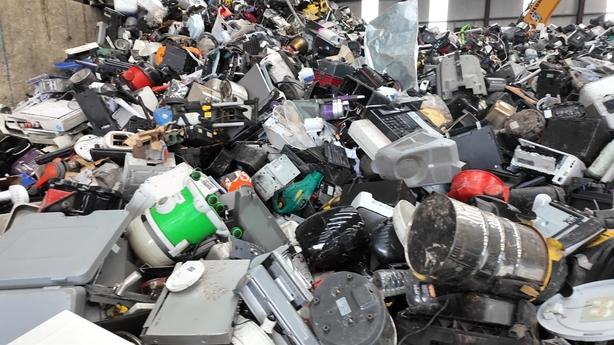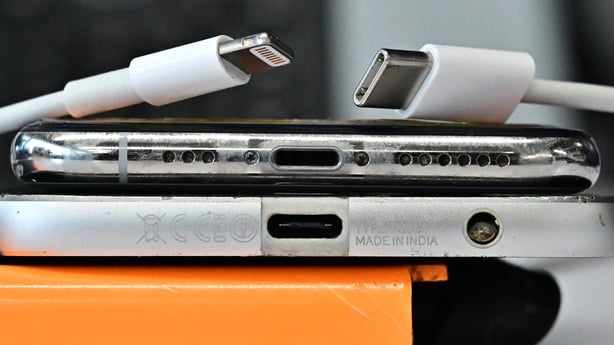Few would have predicted that the McFlurry would become an issue in the US Presidential election campaign.
But it did, briefly.
The fact that McDonald's ice cream machines are regularly out of order is a long-running joke and frustration among customers.
So much so that someone has actually built a website that uses delivery apps to track the status of ice cream machines in McDonald’s around the US.
At the time of writing, nearly 15% of machines in the country were out of order – with more than 30% of outlets in New York unable to sell McFlurrys.
The problem has generated tonnes of memes about the problem. So, given how now President elect Donald Trump tried to hone in on the frustrations of those online, it’s perhaps no surprise that he picked up on the McFlurry as a campaign tactic.
In fairness, he didn’t exactly make it a central plank of his election bid – but a few days his visit to a McDonald’s in Philadelphia, Trump’s account on his Truth Social platform, posted saying: "WHEN I’M PRESIDENT THE MCDONALD’S ICE CREAM MACHINES WILL WORK GREAT AGAIN!"
The weirdness of this being a campaign issue aside, some may have laughed at the idea that the political system could do anything about McDonald’s ice cream machines.
But it turns out it can. In fact, the Biden Administration had already beaten Trump to the punch.
It all goes back to the reason McFlurry machines are so regularly broke,.
In the US at least they are made by a firm called Taylor Company. And under the deal they have with McDonald’s, only licensed Taylor Company technicians are allowed to repair the machines.
If anyone else tries to fix one, the warranty is voided.
We need your consent to load this rte-player contentWe use rte-player to manage extra content that can set cookies on your device and collect data about your activity. Please review their details and accept them to load the content.Manage Preferences
That has meant that a McDonald’s operator with a broken machine had to wait for one of a limited number of technicians to come and fix it. And it probably cost them more than it would for a regular engineer.
But that changed recently – in fact it changed just days before Trump’s post.
The Federal Trade Commission in the US recently applied to the United States Copyright Office for a copyright exemption on certain equipment – including soft-serve ice cream machines.
And that came after it specifically looked into the issue around McFlurry machines.
The change means that a company, like Taylor, can no longer gatekeep repairs. Now anyone can fix a broken machine.
And this is all part of a movement that has been gaining momentum in the US – but also in the European Union – around the right to repair.
What is the right to repair?
This is a movement based on a concept that goes back to the early days of electronics – but that started to gain real momentum in the 90s.
It is essentially the idea that it should be as easy and affordable as possible for consumer to repair the products they own – big or small.
And it grew from this slow creep that’s happened in consumer devices where products have become more locked down.
More a more companies have used repair-unfriendly design, or they’ve put lots of proprietary parts inside. Some companies even use custom screws to make it harder for people to open things up and see what’s going wrong.
Or they have software that shuts down a device if an unauthorised part is detected.
And it’s a problem that goes all the way from printers refusing to use ink cartridges that are made by another company, to computers where the hard drive is soldered in place, to mechanics needing to have specialised – often very expensive – software in order to diagnose problems in some models of car.
And this has become a really big issue today.
Most people will have encountered cases where the only way to fix an appliance is to go to the manufacturer itself, or to one of a handful of approved technicians. That means they have little choice but to pay the price that they quote you.
And there are times when the cost of repairing the device or item is actually higher than the cost of replacing it altogether.
So the right to repair movement is about trying to reverse that – and to oblige companies to make repair as easy and accessible as possible.
And it’s a movement that’s had some wins in recent years…

Yes. In parts of the US, and in certain cases nationally - like the one with the ice cream machines.
But it’s the European Union that has probably been more forceful and comprehensive in its approach.
Earlier this year the European Parliament overwhelmingly passed a directive on the right to repair, which sets out a range of obligations on manufacturers.
First and foremost they are required to provide timely and cost-effective repair services – and inform consumers about their rights around repair.
Manufacturers will also have to provide spare parts and tools at a reasonable price. And they won’t be allowed to use any techniques to block repairs – like contracts that void warranties, or software that blocks repairs.
They also cannot block second hand or third party parts from being used in repairs.
And they’ll have to support the repair of common household products even if they’re out of warranty – which it is hoped will mean that products will be supported even if they’re not the latest and greatest model.
Alongside all of that, there are plans for a Europe-wide information service on how people can go about repairing their goods, where they can go to get something fixed, where they can sell their defective products that maybe they don’t want to fix - but someone else will - and where they can buy refurbished goods too.
And member states will be required to bring in some kind of initiative to encourage repairs – for example offering vouchers towards the cost of repair, funding repair courses, or supporting community spaces for repairs.
Why is there such a big push for this now?

The right to repair idea has been knocking around for decades – and for a long time it was focused on consumer choice.
That is all well and good, but when it goes up against very wealthy companies - who can spend a lot of money lobbying against any proposals - it’s just not enough.
But another element of the right to repair movement was also focused on the environmental side of this – and how so much waste is being created by the pressure on consumers to entirely replace broken down products, rather than simply repairing them.
And it’s really that side of the argument that has gained traction in recent years – and has led to the push towards stronger rules on repair.
Because the EU has put a lot of focus on reducing emissions and reducing waste in recent years – and trying to improve the environmental record of the bloc.
And so, if you can put together a system that reduces the amount of electronic waste that’s being generated by consumers – that will go some way towards the region’s overall environmental targets.
The European Commission claims that the premature disposal of consumer goods produces the equivalent of 261 million tonnes of Co2 emissions each year.
That’s more than four times Ireland’s total emissions last year.
30 million tonnes of resources are used in the process, with 35 million tonnes of waste being created in the process.
And the fact that it also happens to be something that’s pro-consumer, and hopefully a money-saver, is a bonus.
The commission estimates that EU consumers are losing around €12 billion each year because they have to spend money to replace something that they should be able to repair.
So the hope is that loss will be reduced significantly in the future – and it should benefit everyone.
Because even if you’re not inclined to try to repair your devices yourself, the directive will hopefully mean that it’s easier for you to find someone else who can… and it should be a bit cheaper to get the job done than would have been the case, too.
Not to mention the fact that it will help to boost the availability of reliable second hand devices.In recent years there has been a growth in electronics resale sites for smartphones and tablets.
It means that people can get a decent device for much cheaper, if they’re willing to buy one that’s a year old.
How do companies feel about this?

It’s been a fairly mixed response – but at the same time a lot of firms have seen what way the wind is blowing.
Apple is maybe the company that best exemplifies the anti-repair trend of the past decade or two.
It has become notorious for creating devices that are hard to repair, and for putting up all sorts of hurdles to make it harder for anyone else to fix its devices.
And it would have pushed back against right to repair proposals in the past – but even it has changed its approach in recent years.
Part of that was because of pressure from within.
For years it has talked a good game about its environmental credentials, but one of its activist shareholders pointed out that it was being hypocritical by making repairs so difficult.
Today it is easier than ever to get your hands on official repair kits for the likes of the iPhone – and more places are able to offer approved device repairs.
But that’s not to say that things are now perfect.
By design some products are still fairly repair unfriendly.
Smartphones are actually a good example of that – not just Apple’s.
They pack so much into such a small space, and they’re designed to be waterproof and dustproof, so prying them open without doing damage can actually be quite tricky.
Earbud type headphones also have a really bad repairability score – because again, they’re so small, all the components are soldered together, and then they casing is glued shut.
And that means that if anything goes wrong – or when the tiny battery eventually stops holding a charge – you just have to throw the whole thing in the bin.
And they’re so hard to disassemble they’re even pretty poor in terms of their recyclability.
Other features on Apple devices that have butted up against the right to repair rules include its policy on 'parts pairing’.
That’s where a new part is checked to ensure it’s not trying to tap into your data, or that it’s not from another, stolen device.
Using unapproved parts has led to certain features becoming unavailable to users.
In some ways it’s quite a consumer-positive measure by Apple – but some see it as them trying to add new hurdles to the repair process.
Though they have said that they’re making changes to newer models to try and make sure they can keep this security step while also facilitating repairs.
But the right to repair isn’t just about phones and washing machines, is it?

No – the EU directive is very much focused on consumer goods – but it really has implications way beyond that.
Some types of car now require specialised diagnostic software in order for mechanics to undertake repairs.
And given how modern cars are increasingly tech-heavy, and increasingly reliant on specialised sensors, and proprietary parts, they’ve become much harder to repair.
In the past decade or so it’s gotten much harder for a consumer to fix something in their car and it’s now getting to the point where even mechanics might struggle in some cases.
Having these kinds of right to repair laws will hopefully push back against that – and stop a situation where you have to go to the dealership or a specialist just to get a small part changed.
And as the McFlurry case shows, this is also important in terms of the commercial and industrial machinery that companies use.
This is something that some farmers will have experience with – as there has been a long-running dispute involving John Deere, which has been accused of holding a monopoly over the repair of its equipment.
The company has made promises to improve the amount of information it gives customers and mechanics so they can more easily do the work themselves – but many are sceptical that they’ll go far enough.
So if there is a continued push at a political level, that will help to lower the barriers and the costs for producers and companies.
And that will hopefully, ultimately, be a positive for consumers too.







